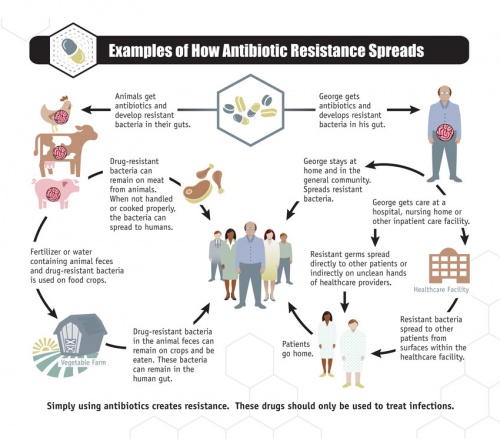Team II Genome Assembly Group: Difference between revisions
No edit summary |
mNo edit summary |
||
| Line 3: | Line 3: | ||
=== Background === | === Background === | ||
Antibiotic resistance has been called one of the world’s most pressing public health problems. Antibiotic resistance is the ability of bacteria to resist the effects of an antibiotic. It occurs when bacteria change in a way that reduces the effectiveness of drugs, chemicals, or other agents designed to cure or prevent infections. The bacteria survive and continue to multiply, causing more harm (Figure 1). Antibiotic resistance can cause illnesses that were once easily treatable with antibiotics to become dangerous infections, prolonging suffering for children and adults. Antibiotic-resistant bacteria can spread to family members, schoolmates, and co-workers, and may threaten your community (Figure 2). Antibiotic-resistant bacteria are often more difficult to kill and more expensive to treat and in some cases, can lead to serious disability or even death [1]. | Antibiotic resistance has been called one of the world’s most pressing public health problems. Antibiotic resistance is the ability of bacteria to resist the effects of an antibiotic. It occurs when bacteria change in a way that reduces the effectiveness of drugs, chemicals, or other agents designed to cure or prevent infections. The bacteria survive and continue to multiply, causing more harm (Figure 1). Antibiotic resistance can cause illnesses that were once easily treatable with antibiotics to become dangerous infections, prolonging suffering for children and adults. Antibiotic-resistant bacteria can spread to family members, schoolmates, and co-workers, and may threaten your community (Figure 2). Antibiotic-resistant bacteria are often more difficult to kill and more expensive to treat and in some cases, can lead to serious disability or even death [1]. | ||
[[File:1.jpg| | [[File:1.jpg|400]] [[File:2.jpg|500px]] | ||
'''Figure 1. How Antibiotic Resistance Happens''' | '''Figure 1. How Antibiotic Resistance Happens''' | ||
Revision as of 12:37, 4 March 2018
Introduction
Background
Antibiotic resistance has been called one of the world’s most pressing public health problems. Antibiotic resistance is the ability of bacteria to resist the effects of an antibiotic. It occurs when bacteria change in a way that reduces the effectiveness of drugs, chemicals, or other agents designed to cure or prevent infections. The bacteria survive and continue to multiply, causing more harm (Figure 1). Antibiotic resistance can cause illnesses that were once easily treatable with antibiotics to become dangerous infections, prolonging suffering for children and adults. Antibiotic-resistant bacteria can spread to family members, schoolmates, and co-workers, and may threaten your community (Figure 2). Antibiotic-resistant bacteria are often more difficult to kill and more expensive to treat and in some cases, can lead to serious disability or even death [1].


Figure 1. How Antibiotic Resistance Happens
Data
Objectives
- A
- B
- C
- D